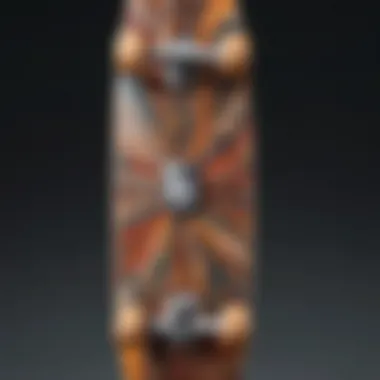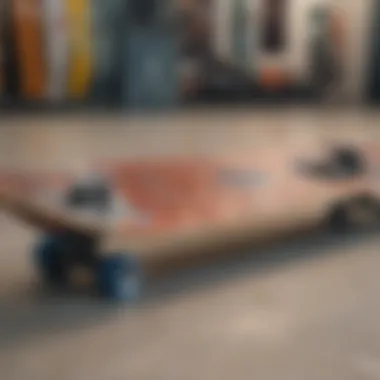Designer Skateboards: Where Art Meets Functionality


Intro
The world of skateboarding is not just about speeding down asphalt or pulling off mid-air tricks; it’s a fascinating blend of culture, lifestyle, and artistry. At the heart of this chaotic yet exhilarating sport lies a compelling intersection of art and utility. Designer skateboards have emerged, not just as mere tools for skating but as canvases displaying creative prowess. To truly grasp their significance requires an exploration beyond the surface, diving into how these boards have transformed over the years.
Designer skateboards possess unique qualities that elevate them from regular boards. They signify a narrative—a story spun from the exceptional minds of artists and designers polished through experience. When skateboards become a medium of expression, they challenge conventional notions of utility tend to lose itself in the shadows of modernity. A skateboard isn’t simply a board anymore; it shares a voice.
In this piece, we will unpack various facets that contribute to the prominence of designer skateboards, from tricks that define the sport to cultural impact and market trends shaping collectors' interests. As we go through this journey, the intricate relationship between artistry and practicality will unravel, providing a comprehensive view of this niche's relevance in contemporary society.
Understanding Designer Skateboards
In today's fast-paced world, skateboards have transcended their original purpose, evolving into a canvas for creativity and a statement of identity. Understanding designer skateboards is crucial for enthusiasts, marketers, and collectors alike, as they encapsulate the fusion of art and utility while reflecting cultural trends and personal expression. This section explores the key elements that define designer skateboards, their significance, and the various layers that contribute to their appeal.
Defining Design in Skateboarding
Design in skateboarding is not merely about aesthetics; it encompasses functionality, ergonomics, and the rider's experience. At its core, a skateboard's design must facilitate performance while serving as a medium for artistic expression. For example, the curvature of a skateboard deck can significantly impact tricks and maneuverability. Often, riders look for decks that are not only visually appealing but also contribute to how well they skate.
A contemporary designer skateboard often features:
- Customized graphics that reflect the rider's personality or the aesthetics of modern art movements.
- Unique shapes and sizes tailored to specific styles of riding, whether it's street, park, or vert skating.
- Materials that enhance durability while maintaining a lightweight structure, such as bamboo or composite blends.
As skaters exchange boards and share their experiences online, they create a vibrant community where design plays a pivotal role. This reflects the value placed on individual style and the importance of choosing a skateboard that resonates personally.
The Evolution of Skateboard Design
The evolution of skateboard design mirrors the broader cultural shifts and trends in society. In the early days, skateboards were simple wooden planks attached to roller skate wheels, serving a functional purpose without much emphasis on design. As skateboarding grew in popularity during the 1970s and 1980s, the designs began to evolve rapidly.
- 1970s: Skateboards started to feature wider decks and new shapes like the famous 'fish tail,' improving performance and agility. Graphics from this era often drew inspiration from punk music and surf culture.
- 1980s: The introduction of graphics took a center stage as artists like Marc McKee brought street art styles to skateboards. This era birthed iconic brands like Powell Peralta and Santa Cruz, emphasizing personality over mere utility.
- 1990s and Beyond: The rise of the internet and social media accelerated the trend of designer skateboards. Brands began collaborating with well-known artists, extending the boundaries of skateboard graphics into collectible art pieces, appealing to both skaters and art enthusiasts.
Today, skateboard design continues to push the envelope. From biodegradable materials to boards that integrate technology for tracking performance, the future remains bright. The design isn’t just about looking good; it’s about creating a viable product that blends aesthetics with performance where both the art lover and the average skater can find common ground.
"Skateboards are not just tools; they are a reflection of our identity and culture."
In essence, understanding designer skateboards prompts a deeper appreciation of how they serve as a bridge between art and functionality. As we dive into their historical context and the designers behind them, we shall see how these components come together to form a vital aspect of skateboarding culture.
Historical Context
The historical backdrop of skateboarding is critical to grasping the essence of designer skateboards. Skateboarding didn't just spring up overnight; it is an art form evolved through myriad influences and cultural shifts. This section elaborates on how the origins of skateboarding laid the groundwork for designer skateboards, offering insights that range from early innovators to the philosophical underpinnings influencing design today.
Skateboarding Origins
Skateboarding emerged in the late 1940s and early 1950s in California, particularly among surfers who wanted to mimic the wave-riding experience on land. The early models, often homemade from wood or scrap materials, were rudimentary at best and reflected a much simpler time. These boards weren’t just tools for sport; they became a canvas of sorts, showing personal styles and preferences–often adorned with stickers, paints, or unique modifications.
The evolution continued steadily through the 1960s, when manufacturers like Hobie and Makaha stepped onto the scene, introducing mass-produced boards. As the sport gained traction, skaters began experimenting with their riding styles and, subsequently, the designs of their boards.
By the time the 1970s rolled around, skateboarding was not merely a pastime; it transcended into a cultural phenomenon. It brought forth the influence of punk rock music and the burgeoning skateboard subculture, where individuality played a massive role. Board designs began displaying vibrant art and bold colors, capturing the punk aesthetic and conveying a unique identity. Each skater told their story through their choice of board—a statement not only about their style but also about the new societal norms surrounding youth culture.
Here’s how these early days shaped what we now recognize as designer skateboards:


- Cultural Identity: The early skaters turned their boards into markers of identity. Artists often collaborated with skaters, leading to new artistic expressions on decks.
- Functional Art: The distinction between art and utility blurred. Boards not only needed to perform well but also to look appealing, which is a core principle of designer skateboards today.
- Community Engagement: The origins of skateboarding were grounded in rebellion and creativity. Communities formed around local skate spots, and this sense of belonging influenced the art and design of boards.
Cultural Influences on Skateboard Aesthetics
Fast forward to the ’80s and ’90s, skateboard aesthetics began to truly flourish. The introduction of street skating led to a wave of graphic design influences that incorporated everything from graffiti to pop culture references. Iconic skateboard brands such as Santa Cruz and Element were instrumental at this time, using celebrity artists like Jim Phillips to create decks that were as much about artistic vision as they were about performance.
Skateboards became a reflection of larger societal themes—anti-establishment sentiments, vibrant youth culture, and the raw artistry found in urban environments. This period also witnessed a crossover with contemporary art, as established artists began to seek inspiration from the raw, unfiltered world of skating.
Some notable cultural influences include:
- Street Art: The emergence of street art has played a pivotal role. Techniques borrowed from graffiti have influenced skateboard graphics, creating a crossover between urban art and skateboarding.
- Music: Music genres like punk, hip-hop, and later electronic music became intertwined with skate culture, reflecting in the boards' designs and pushing artists to explore new visual languages.
- Fashion Trends: Skateboarding aesthetics could not be divorced from the fashions that accompanied it. With each new trend, decks displayed colors, prints, and motifs that aligned with what was considered hip at the time.
"Skateboards are not merely modes of transportation; they’re canvases that wind through the streets, telling stories of a culture built on creativity and rebellion."
As we dissect the evolution of skateboarding, it's imperative to look back and recognize how these historical components laid the groundwork for what designer skateboards have become in the contemporary landscape. The interplay of functionality and artistry has never been clearer, providing a lens through which both skaters and collectors engage with their boards.
Key Designers and Brands
Designer skateboards are more than just a means of transportation; they are a canvas for creativity, a statement of identity. The role of key designers and influential brands is thus paramount in defining this blend of art and utility. Each skateboard tells a story, often rooted in personal experience or societal trends, which resonates with a diverse audience from skaters to art lovers. This section will explore the significance of these pioneers in shaping the landscape of skateboarding culture and how their craft has influenced both aesthetics and functionality.
Prominent Designers in the Skateboarding World
When you think of skateboarding, names might come to mind that go beyond just functional design. For instance, Ed Templeton, a prolific artist and skater, infuses his skateboards with his life experiences and skate culture's essence. His decks are not just for skating; they serve as a cultural commentary, often addressing themes like identity and social issues. Another notable designer is artist Haroshi, who uses repurposed skateboard wood to create intricate sculptures and decks. Haroshi’s work speaks volumes about environmental awareness and recycling within the skate community, merging functionality with a strong message.
"A skateboard is a reflection of the rider. It’s where art meets the grind of daily life." - An industry insider.
In addition, there’s Jason Jessee, known for his unique graphic styles that have nearly become legends in their own right. Each design elevates the board from mere equipment to an artistic artifact, beloved even when hung on walls rather than used on streets. Designers like Jessee have taken the approach of integrating art into the very fabric of skateboarding, making statements that extend well beyond the skatepark.
Influential Skateboard Brands
If individual designers carve their mark, certain brands have created ecosystems that harbor and promote this intersection of art and utility. Companies like Santa Cruz Skateboards are not just about producing decks; they are about fostering a culture that celebrates creativity. The brand has collaborated with many eminent artists, blending distinct designs with performance-level materials. In effect, their skateboards often represent a perfect union of form and function.
Moreover, Element Skateboards has also positioned itself as a leader in eco-friendly practices within the industry. They use sustainable materials in their skateboard production and have embraced social responsibility, which resonates with a generation increasingly concerned about environmental issues.
Let’s not forget about brands like Girl Skateboards, known for their strong ties to the skateboard community and commitment to championing innovative art through deck designs. They often bring an eclectic mix of styles, respecting the roots while pushing the boundaries of skateboard design.
Brands also engage in large-scale collaborations with established artists, such as the limited editions seen with brands like Baker Skateboards and their partnership with various underground artists. They breathe fresh life into the brand’s narrative, driving collector interest and appreciation.
To summarize, the essential role that renowned designers and brands play cannot be understated. Each piece produced is not only an invitation to ride but also an artistic statement, unifying both the individual expressing themselves and the collaborative spirit found in skateboarding. This connection between collective culture and design methodology continues to shape the future of skateboards.
Elements of Skateboard Design
When we talk about designer skateboards, it’s clear that functional elements meld seamlessly with artistic flair. Understanding the core components of skateboard design reveals not just how these boards perform, but how their beauty resonates with riders and collectors alike. Various elements contribute to the skateboard's usability and aesthetic appeal, defining the overall riding experience.
Materials Used in Designer Skateboards
Materials are at the heart of skateboard construction. Traditional skateboards often relied on maple wood for its resilience and flexibility. However, today’s designer skateboards take full advantage of a diverse array of materials, pushing boundaries in both durability and design.


Common Materials Include:
- Bamboo: Known for its light weight and high strength, bamboo boards provide a unique flex, attracting eco-conscious riders due to its sustainability.
- Fiberglass: This material adds a layer of toughness, making boards more resistant to scratches and impacts. It's often used in hybrid designs to enhance performance.
- Carbon Fiber: This high-end material significantly reduces weight while increasing strength. Riders often prefer carbon fiber for competitive skating due to its superior performance.
- Metal: While less common, some designers integrate metal edges or components, giving boards an industrial twist while improving grind capabilities.
- Recycled Materials: An emerging trend, these boards showcase creativity and environmental responsibility, appealing to a generation seeking to make a statement.
Choosing materials isn’t just about aesthetics; it affects everything from the board's rigidity and weight to its resilience under stress. Riders must consider what feels right for them based on their skating style.
Critical Design Features
Beyond materials, the structure and style of a skateboard play a pivotal role in its performance. Various design features can significantly alter how a board skates and looks.
Key Features To Consider:
- Shape: The shape of a skateboard—whether a classic popsicle shape, a cruiser deck, or a trick board—determines its intended use. Each shape has its unique handling characteristics and rider experience.
- Concave: Refers to how the top surface of the board dips inward. A deep concave can enhance grip and control during tricks, proving especially useful for street skaters.
- Wheelbase: The distance between the front and back wheels affects stability and turning radius. A longer wheelbase often provides more stability, while a shorter one allows for tighter turns.
- Graphics: While often seen as mere decoration, graphics can carry personal meaning or cultural significance for both the designer and rider. The combination of color, design, and imagery becomes a form of personal expression for skaters.
"The skateboard is not just a tool; it is an expression of individuality, blending art with movement."
- Trucks and Wheels: Quality trucks and wheels are foundational. Different truck heights can influence ride height, while wheels vary in hardness affecting grip and slide. Choosing wisely based on the type of skating can make or break the experience.
As one can see, the elements of skateboard design are not mere afterthoughts—they are integral to the art of skateboarding itself. Understanding these factors can help skaters make informed choices, merging their individual style with functional performance.
Market Trends and Consumer Behavior
Understanding market trends and consumer behavior in the realm of designer skateboards is crucial for several reasons. It paints a picture of how the availability of unique designs influences purchasing choices, impacts brand loyalty, and shapes the very identity of skateboarding culture. Skateboard consumption isn’t just about functionality; it’s intertwined with identity, perception, and even a sense of belonging among enthusiasts and collectors.
The Rise of Collectible Skateboards
The landscape of skateboarding has certainly witnessed a significant rise in collectible skateboards. What started as a simple mode of transport for thrill-seekers has transfigured into a realm where skateboards are not only tools for sport but also artwork that commands attention and respect. Limited editions and signature decks have become treasures, appealing to collectors who view them as a blend of art and sport.
For instance, a skateboard produced by a renowned artist or one that features iconic artwork can sell for thousands. The aesthetic value these boards hold far outweighs their practical use for some skaters. This burgeoning trend has reshaped the marketplace in many ways:
- Increased valuation: Unique designs and limited runs have produced boards that increase in value, similar to art pieces or collectibles.
- Investment culture: With many buying skateboards to hold rather than use, a unique investment culture has emerged.
- Nostalgia factor: Collectors might chase boards from their youth, adding sentimental value to their collections.
In this environment, social media platforms, such as Instagram and Reddit, have become fertile ground for enthusiasts to showcase their prized decks. Add in forums and groups where skaters exchange insights about their collections, and the collector’s market continues to thrive.
Target Demographics for Designer Skateboards
Identifying the target demographics for designer skateboards reveals a tapestry of interest groups that extends beyond traditional skaters. While long-time enthusiasts remain core consumers, various segments have emerged:
- Young Adults: This group often embraces skateboarding as a lifestyle choice, gravitating towards artistic expression rather than solely practical purposes.
- Parents: Many parents are purchasing designer boards for their children, seeking both quality and aesthetics. They appreciate the blend of fun and art, emphasizing durability and style.
- Collectives of Artists: Artists and designers often intersect with the skateboard scene, producing artistic boards that appeal to those who appreciate craftsmanship along with performance.
- Investors: A growing number of people view skateboards as investment opportunities, drawn in by the potential for monetary appreciation.
Understanding these demographics helps marketers shape strategies that resonate, employing platforms where these groups gather online. Adult collectors may favor Facebook groups focusing on nostalgic boards, whereas younger consumers might look to find inspiration on TikTok or Instagram.
Impact on Skateboarding Culture
The influence of designer skateboards on skateboarding culture is profound, essential, and multifaceted. This impact touches various aspects of life, from personal identity to community, thus showcasing how these crafted boards represent more than just a functional item. They often embody the spirit and ethos of the skating community, fostering an environment where creativity and self-expression thrive.
Designer Skateboards in Popular Media


In the realm of popular media, the role of designer skateboards can hardly be overstated. Skateboards frequently pop up in films, music videos, and even art exhibitions. For instance, Tony Hawk's appearances in various television shows and movies have elevated the status of skateboards to a level where they're recognized as cultural artifacts.
The likes of the documentary "Dogtown and Z-Boys" and the more recent film "Mid90s" illustrate the vibrant skateboarding scene, shedding light on the diverse personalities and styles that define it.
Moreover, artists like Shepard Fairey and Banksy have transformed skateboards into canvases of modern art, intertwining the realms of sports and visual creativity. Occasional collaborations, such as those between skateboard brands like Element and renowned visual artists, highlight the ongoing dialogue between art and sport. It’s a testament to how designer skateboards resonate not only within the skateboarding community but also with wider audiences, reinforcing skateboarding’s foothold in mainstream culture.
"Skateboards are not just ride-ons; they are stages for personal expression, a mobile piece of art that reflects its owner."
The Fusion of Art and Sport
The fusion of art and sport is a critical aspect of designer skateboards that merits in-depth discussion. The art of skateboarding amounts to more than mere tricks; it's about the individuality that each skateboard exudes. Each design has its story, and many boards are adorned with unique graphics that speak volumes about the creator's vision.
This blending provides numerous benefits:
- Increased Awareness: It brings skateboarding into discussions about art and culture, expanding its appeal well beyond the skating demographic.
- Inspiration for New Generations: Young skaters are often influenced by the aesthetic of their boards, inspiring them to innovate and create.
- Inclusivity: The accessibility of art means that anyone can bring their artistic flair to skateboarding, breaking barriers and fostering a sense of community.
One only needs to look at events like the S.L.A.T.E. show at the Agenda trade show, where skateboard companies showcase their latest designs. These platforms often feature limited releases that turn skateboards into collectibles appreciated by both athletes and art aficionados alike. Designers, therefore, not only fulfill a need for functional equipment but also create pieces that spark conversations around both style and performance.
Through these interactions, designer skateboards become a bridge connecting diverse communities, offering a glimpse into the ethos of art and sport interwoven in everyday life. It’s this unique aspect that continues to shape the culture of skateboarding, ensuring its place in both sports and art realms.
Future Directions
The future of designer skateboards is anything but stagnant. As the landscape of both art and skate culture continues to shift, so too do the inspirations and methodologies behind skateboard design. Recognizing the importance of this topic helps us appreciate how aesthetics and functionality can evolve together, making skateboards not only tools for sport but also canvases for artistic expression. The synthesis of creativity and utility may very well shape how future generations interact with this skateboard culture.
Emerging Trends in Skateboard Design
In the world of designer skateboards, innovation is the name of the game. One significant trend gaining momentum is the integrative approach to design. Designers are no longer just focusing on how a skateboard looks; they're also thinking about how it performs. This convergence of form and function aims to enhance the rider's experience while pushing the envelope of visual art. A few key trends emerging in this arena include:
- 3D Printing Technologies: The use of 3D printing in skateboard design allows creators to experiment with shapes and materials that were previously unfeasible. Customization becomes an exciting avenue for both art and utility, providing riders with boards tailored to their specific needs.
- Collaborative Pieces: Partnerships between artists and skateboard brands are becoming more frequent. Through these collaborations, brand identity and artistic expression blend to create limited edition boards that tell a story. These pieces often resonate with collectors and enthusiasts who appreciate both skate culture and fine art.
- Innovative Material Usage: Designers are exploring an array of new materials, including sustainable options, to enhance durability while maintaining a lightweight feel. This not only opens doors for better performance but also appeals to eco-conscious consumers.
Sustainability in Skateboarding Products
As awareness about environmental issues grows, the skateboard industry is not left behind. There’s an urgent push for sustainability in skateboard production. This shift goes beyond using eco-friendly materials; it encompasses the entire lifecycle of the product, from creation to disposal. Important considerations include:
- Using Recycled Materials: Some brands have begun leveraging recycled plastics and woods in their boards. This approach not only decreases waste but also becomes a selling point for an increasingly environmentally-aware audience.
- Longevity in Design: Creating boards that are meant to last longer reduces the frequency of replacements. Designers are focusing on enhanced durability while still maintaining an appeal that attracts skaters.
- Transparent Practices: Many brands are becoming more open about their sourcing and manufacturing processes. Consumers appreciate transparency and may choose products from companies committed to sustainable practices.
The intertwining of artistry and responsibility indicates a bright future for designer skateboards. As designers and riders alike embrace these forward-thinking approaches, skateboarding culture stands to gain depth and richness, reflecting not only personal style but also a conscientious attitude towards our globe.
"The evolution of skateboard design is a reflection of our collective priorities and inspirations. As we skate into the future, the art of the board must align with our responsibility to the environment." - Anonymous
Epilogue
Understanding designer skateboards requires an appreciation of how art and function come together in a uniquely expressive way. The evolution of these boards illustrates broader cultural shifts and personal narratives woven into each design. This section sheds light on not only the aesthetic and utilitarian aspects of skateboards but also their impact on community identity and self-expression.
The Continuing Evolution of Designer Skateboards
The landscape of designer skateboards is constantly shifting, influenced by technological advancements and changing artistic visions. Often, trends emerge from what riders express through social media, showcasing their creativity and unique styles. In today's world, designers like Jeff Grosso and companies such as Element have pushed boundaries, emphasizing sustainability and recycled materials in their production processes. This underscores a shift towards environmental awareness without compromising on style or performance. Traditional wooden boards, which were once the standard, are now often fashioned from eco-friendly sources, reflecting a growing movement towards conscious consumerism. This evolution is not just about the physical board, but also about the stories that they tell.
Final Thoughts on the Art of Skating
Skateboarding is as much about movement and balance as it is about the artwork that adorns the boards. The relationship skaters cultivate with their boards can be deeply personal. Much beyond a means to get from point A to B, these boards often double as canvases, enabling skaters to express individuality in ways that might not be possible elsewhere in their lives. This fusion between sport and art is not simply a trend; it has established its own culture and community that resonates with people around the world. As designer skateboards continue to thrive, they bridge gaps between various aspects of life—artistry, functionality, and community—supporting a rich tapestry of narratives that continues to inspire generations.
"Skateboards are not just tools; they are expressions of identity and creativity. The designs we choose reflect who we are and how we see the world."
As we look towards the future of skateboarding, it’s clear there's immense potential for more innovation, creativity, and sustainable designs. Designers are at the forefront of this evolution, shaping the very nature of this urban art form. Art and utility will continue to intertwine, making designer skateboards not just a mode of transportation but a lifestyle choice that resonates with the inmost aspects of art and self-expression.















